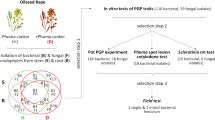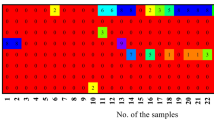Abstract
CAVITY spot, a disease which causes considerable damage to the mature storage roots of carrots in several countries including the United Kingdom and the United States1, has been reported to be caused by calcium deficiency, either actual or induced by excessive potassium levels in the soil2. We have examined diseased carrots in East Scotland since 1966 and have been unable to confirm the relationship with calcium levels. Evidence reported here indicates that pectolytic bacteria of the anaerobic genus Clostridium are the cause.
This is a preview of subscription content, access via your institution
Access options
Subscribe to this journal
Receive 51 print issues and online access
$199.00 per year
only $3.90 per issue
Buy this article
- Purchase on Springer Link
- Instant access to full article PDF
Prices may be subject to local taxes which are calculated during checkout
Similar content being viewed by others
References
Guba, E. F., Young, R. E. & Ui, T. Plant Dis. Reptr 45, 102–105 (1961).
Maynard, D. N., Gersten, B., Young, R. E. & Vernell, H. F. Proc. Am. Soc. hort. Sci. 83, 506–510 (1961).
Lund, B. J. appl. Bact. 35, 609–614 (1972).
Buchanan, R. E. & Gibbons, N. E. Bergey's Manual of Determinative Bacteriology, 8th edn (Williams and Wilkins, Baltimore, 1974).
Author information
Authors and Affiliations
Rights and permissions
About this article
Cite this article
PERRY, D., HARRISON, J. Pectolytic anaerobic bacteria cause symptoms of cavity spot in carrots. Nature 269, 509–510 (1977). https://doi.org/10.1038/269509a0
Received:
Accepted:
Published:
Issue Date:
DOI: https://doi.org/10.1038/269509a0
This article is cited by
-
Microbial population dynamics in response to Pectobacterium atrosepticum infection in potato tubers
Scientific Reports (2015)
-
Calcium-related disorders in plants — a possible explanation for the effect of weather
Plant and Soil (1978)
Comments
By submitting a comment you agree to abide by our Terms and Community Guidelines. If you find something abusive or that does not comply with our terms or guidelines please flag it as inappropriate.



